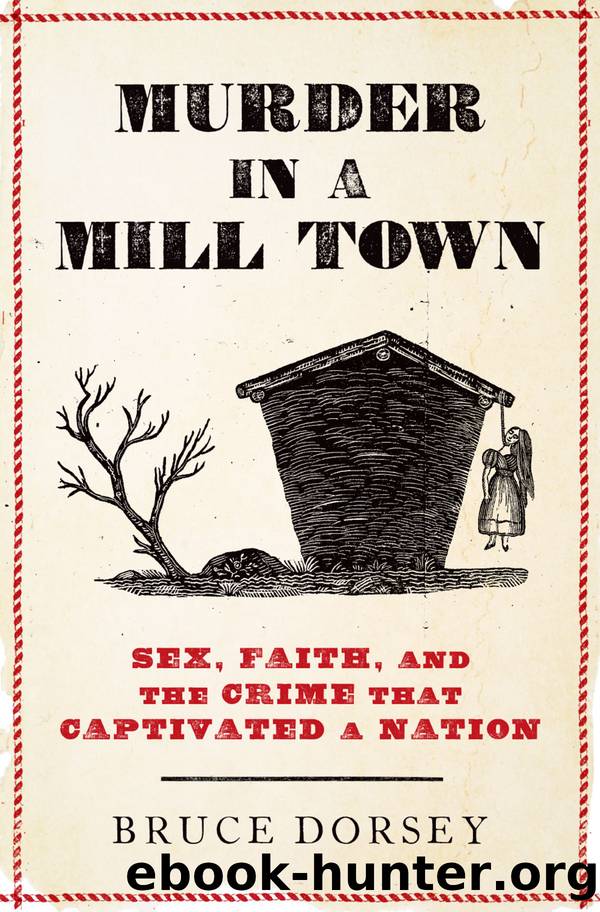Murder in a Mill Town by Bruce Dorsey;

Author:Bruce Dorsey;
Language: eng
Format: epub
Publisher: Oxford University Press USA
Published: 2023-02-15T00:00:00+00:00
âCrazy Kateâ was among the many literary and artistic representations of female insanity in the early nineteenth century. Johann Heinrich Füssli, Die wahnsinnige Kate (1806/07). Courtesy of Freies Deutsches Hochstift/Frankfurter Goethe-Museum, Frankfurt am Main, Germany.
The two doctors who treated Maria Cornell for venereal disease, therefore, proved valuable for the defense. Dr. Graves suggested that he thought Cornell was insane because her language strayed from what he expected from a woman, but the only example he offered was Cornell bragging that she could out-pray and out-preach any of the Methodists.
Dr. Noah Martin, who treated Maria successfully after she resettled at the Great Falls factory, seemed less shady than Dr. Graves, but he was no less inclined to consider questions of sanity as an invitation to talk about womanhood. Quick to note that he didnât think she was âlaboring under mental alienation,â Dr. Martin still pointed to Mariaâs manner of speaking. She was loquacious, he said, and her mode of conversation was irregular, even if coherent. âHer gesticulations were different from what we ordinarily find in females,â he added. She would begin talking about her ailment, dissolve into a flood of tears, and then five minutes later burst into laughter.24
These crude assessments of Maria Cornellâs sanity echoed fears about women workers and new cities, about the unleashing of womenâs sexual desires, and about the chaotic and emotional spirituality of Methodists and their camp meetings. They worked because of powerful associations with the human passionsâa term that could at once connote emotions and vices, spiritual and sexual desires, irrational melancholy, anger and revenge. A catch-all descriptor, âpassionâ allowed the defense to tie together popular conceits about sexual lust, religious frenzy, and unruly women.25
Ironically, doctors who treated venereal disease, whose own practice signaled suspicions about morality, anchored the defenseâs portrait of Maria Cornell as a mixture of two qualities considered dangerous in females: religious excess and sexual excess. Dr. Gravesâs reference to either passion or insanity conjured up images of wild camp meetings, love feasts, unbounded sexual desire, and the bold defiance of mobile, independent women. Dr. Martin proved just as adroit at coupling Cornellâs âmental anxietyâ with âpassion.â
Jeremiah Mason had turned Averyâs defense into the trial of Maria Cornell. In the latter stages of the trial he hammered home how unstable was Cornellâs nature. Her life, he insisted, was at once full of piety and shameless immorality, displaying âhypocrisy and religious enthusiasm mingled with a predisposition to insanity.â Rising to a crescendo, Mason unleashed a sketch of Cornellâs reckless character: âhabitual sensual indulgences, with strong fanaticismâa wild enthusiasm, with morbid sensibility, and strange abstractions of mind.â Calling her âa creature of passion to which she gave unbridled licenseâ evoked all the associations of passion with sexual licentiousness, womenâs excessive emotionalism, and religious fanaticism. Cornellâs religious enthusiasm made it easy to presume her suicide, or at least to explain away uncomfortable evidence of a violent homicide.26
Stories of Maria Cornellâs sexual immorality and her wild spirituality were equally crucial when it came to proving her mental instability.
Download
This site does not store any files on its server. We only index and link to content provided by other sites. Please contact the content providers to delete copyright contents if any and email us, we'll remove relevant links or contents immediately.
| Civilization & Culture | Expeditions & Discoveries |
| Jewish | Maritime History & Piracy |
| Religious | Slavery & Emancipation |
| Women in History |
Cecilia; Or, Memoirs of an Heiress — Volume 1 by Fanny Burney(31339)
Cecilia; Or, Memoirs of an Heiress — Volume 3 by Fanny Burney(30936)
Cecilia; Or, Memoirs of an Heiress — Volume 2 by Fanny Burney(30891)
The Secret History by Donna Tartt(16635)
Sapiens: A Brief History of Humankind by Yuval Noah Harari(13060)
Leonardo da Vinci by Walter Isaacson(11907)
The Radium Girls by Kate Moore(10910)
Sapiens by Yuval Noah Harari(4541)
The Wind in My Hair by Masih Alinejad(4426)
How Democracies Die by Steven Levitsky & Daniel Ziblatt(4401)
Homo Deus: A Brief History of Tomorrow by Yuval Noah Harari(4282)
Endurance: Shackleton's Incredible Voyage by Alfred Lansing(3845)
The Silk Roads by Peter Frankopan(3764)
Man's Search for Meaning by Viktor Frankl(3637)
Millionaire: The Philanderer, Gambler, and Duelist Who Invented Modern Finance by Janet Gleeson(3572)
The Rape of Nanking by Iris Chang(3518)
Hitler in Los Angeles by Steven J. Ross(3440)
The Motorcycle Diaries by Ernesto Che Guevara(3338)
Joan of Arc by Mary Gordon(3260)
